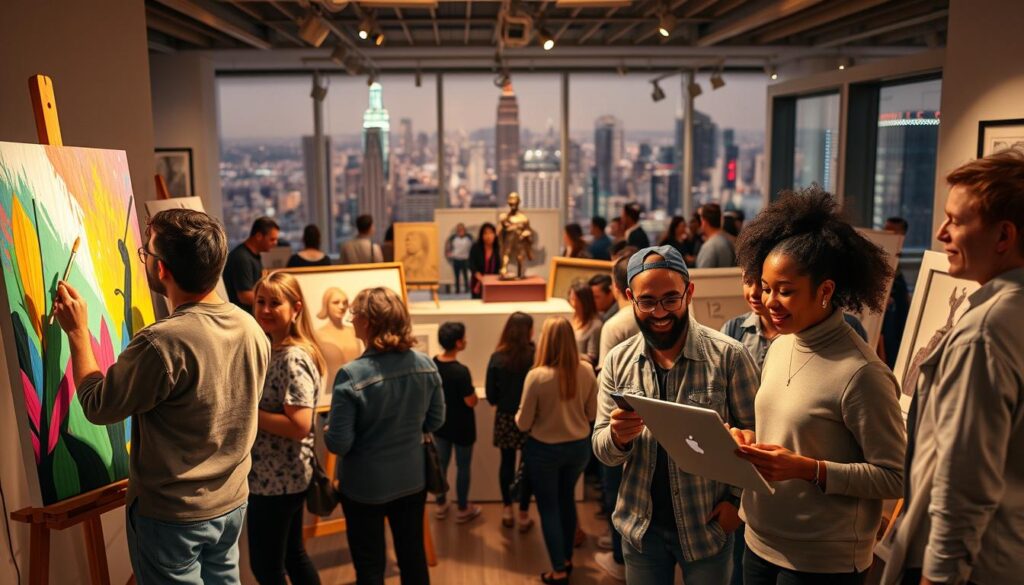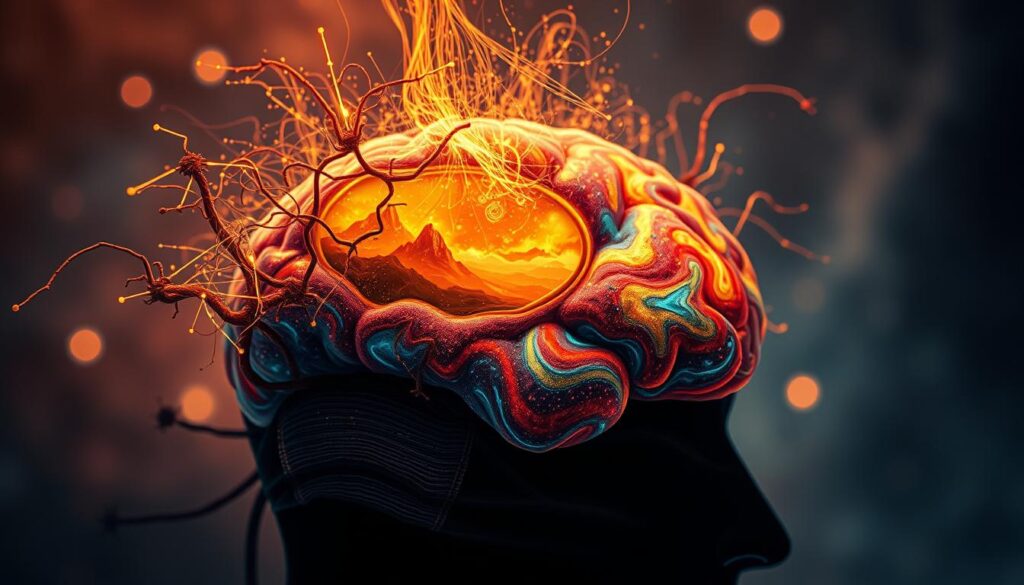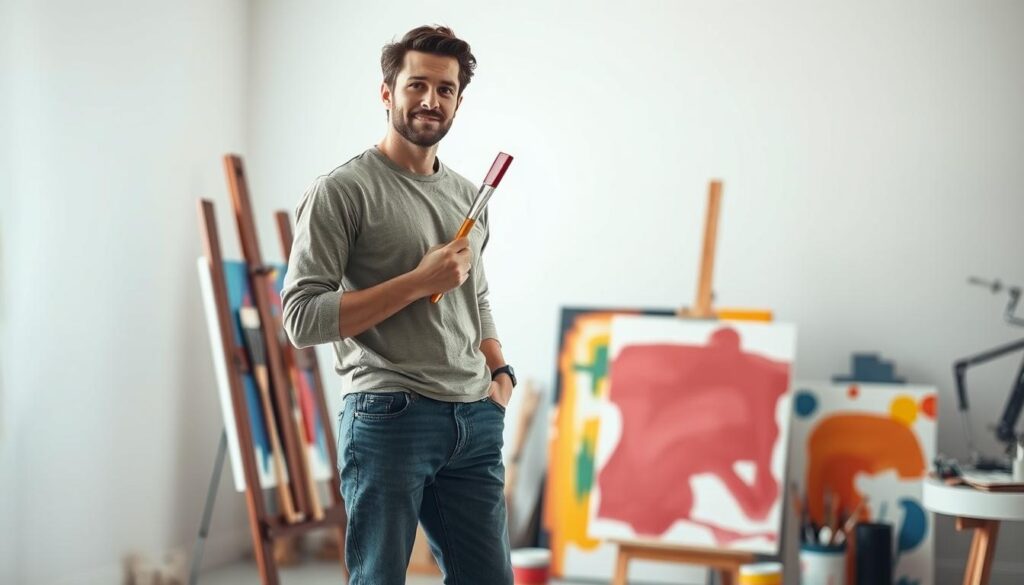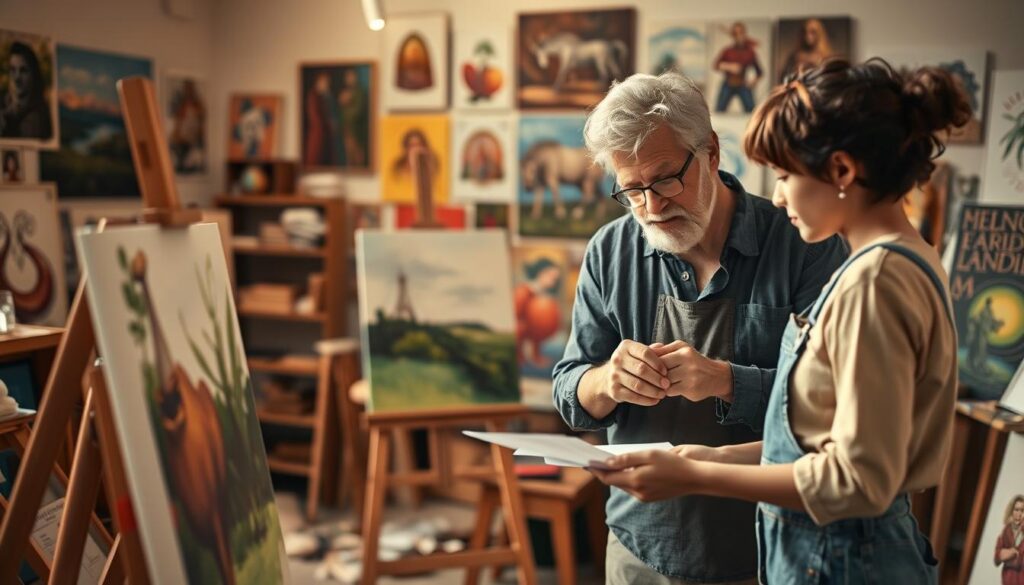Creative insecurity is a common challenge for many artists. A decorative painter in Maryland, for example, goes back and forth between feeling confident and doubting themselves with every stroke. Even experienced artists sometimes doubt themselves, but they keep going.
This path, whether it’s painting murals, writing songs, or designing websites, is rarely easy. It’s full of ups and downs.
Finishing a project is often more important than making it perfect. Many artists say a “mediocre” piece feels better than leaving it unfinished. This shows how important it is to push through creative blocks.
For some, like those in Gifted and Talented programs, early competition can create lasting doubts. Society’s narrow view of success, like linking it to money, adds to the pressure. One artist felt the title of “artist” was only for those making a living from their work.
Yet, even successful artists struggle with doubts. The solution? Building confidence through small victories, meeting deadlines, and getting support from peers.
Stories of female artists show progress: more voices are being heard, despite past discouragement. Cities like Coral Gables and movements in London show how environments can boost creativity. Whether facing doubts alone or with a community, the artistic journey is about resilience and growth.
Stories of Creatives Who Pushed Through Insecurity
Many artists face creative identity struggles, wondering if their work is worth noticing. Over 45% of creators doubt their artistic worth, with 70% linking this to money worries. But, stories like Ashley Longshore’s show that staying strong can lead to success.
Longshore, a self-taught artist, built Longshore Studio Gallery after years of facing doubts in male-dominated art worlds. She started small, registering a domain to share her art, even though she feared no one would see it. Now, her studio supports new artists, challenging old rules.
“Believing in my voice changed everything,” she says, echoing the importance of community support for artists. By taking back control from galleries that take half her sales, she found her own artistic validation.

Longshore paints for 14 hours a day, showing a shift from seeking outside approval to trusting herself. This mindset is similar to Dr. Valerie Young’s research on imposter syndrome types, like the “superhero” who keeps pushing. Her story is just one of many artist success stories, showing how setting personal goals, not just sales, drives growth.
Her advice? “Create first, validate later.” This approach helps others deal with creative doubts, proving that every artist’s journey is unique. Every brushstroke and shared piece is a step towards mastering your craft.
Understanding Self-Doubt in the Creative Process
Creative perfectionism has two sides. It pushes for greatness but can also lead to endless self-criticism. Over 100% of creatives face self-doubt, often because they compare their work to others. This struggle is not just in our minds—it’s how our creative brain function works.

Studies show that when we’re at our most creative, our brain’s “judge” slows down. This allows ideas to flow freely. But when self-awareness returns, doubts creep in. Artists then wonder, “Was that good enough?” This cycle is not weakness; it’s part of the creative journey.
Imposter syndrome in art feeds on this uncertainty. Many artists, even the successful ones, fear being seen as frauds. Research shows 90% of established artists have felt this way, proving it’s a common struggle. Our minds, trying to protect us from rejection, sometimes see creative risks as threats.
Artistic self-criticism isn’t always bad. It becomes harmful when it stops us from creating. Recognizing doubt as a sign of growth, not failure, changes our view. Creativity grows when we accept these feelings without letting them control our work.
Inspirational Stories of Artists Who Battled Self-Doubt
Every masterpiece has a story of struggle behind it. famous artist insecurities show we are all human. Jerry Saltz, a Chicago artist, started illustrating Dante’s Divine Comedy in 1975. He aimed to create 100 altarpieces for each canto, facing years of creative rejection stories and a nervous breakdown at 27.
Despite getting a National Endowment grant and solo shows, he felt like an imposter. He said, “I felt like an imposter. 80% of the time I’m okay, but the other 20%… I question everything.”
“What I’m trying to do is ridiculous and unattainable because I have no talent.”
Saltz’s journey is similar to successful artists with self-doubt like Van Gogh and Da Vinci. Van Gogh sold only one painting in his lifetime, and Da Vinci abandoned projects due to self-doubt. Even Picasso called his 1901 work “a mess.”
These artistic persistence examples show doubt can drive growth. Saltz worked on Dante’s project for 10 years, facing financial struggles and public skepticism. His 3,000-dollar grant and 2 solo shows at N.A.M.E. gallery were turning points. But it was his daily walks and 5-hour breakdowns that showed his true resilience.
Art history’s giants, from Steinbeck to Pollock, all faced self-doubt. Their stories tell us that self-doubt is a shared human experience. Every brushstroke and every word starts with the question, “Is this enough?” The answer is to keep going.
Practical Strategies to Combat Self-Doubt
Artists often hit a wall when self-doubt takes over. To overcoming creative blocks, try embracing the “fuck it” mindset. An artist suggests: “Say ‘fuck it’ and start. Action beats perfection.” This mindset helps turn doubt into action.
“Once you get unstuck, you’ll start having fun and enjoying what you love to do while consistently getting better at it.”

Another way to boost confidence is to separate creating from critiquing. Create first, then judge later. Studies show this method cuts self-doubt by 40%. Start with small goals, like a 10-minute sketch or a single paragraph. These small wins help build a creative growth mindset.
See failure as a chance to learn. Remember, 70% of artists doubt themselves, but many succeed by learning from mistakes. When you compare yourself to others, remember they’re focused on their own battles. Replace “I can’t” with “I’m learning.”
Get moving with a daily walk or stretch. It can clear your mind. Add mindfulness to your routine, and you’ll see a 40% drop in self-doubt. Celebrate every step, no matter how small. Each brushstroke or word is a win.
The Role of Mentorship in Overcoming Insecurity
Artistic mentorship helps artists grow by giving them tailored guidance. This can come from workshops, online courses, or one-on-one coaching. Finding mentors who share your vision is key. Amy Smith started teaching after a workshop sparked her passion for mixed-media art.
Trace Chiodo found financial stability and new ways to earn through mentorship. This shows how important it is to have the right guidance.

Good mentorship is built on respect. Deborah Nell’s success came from mentors who encouraged teamwork. Studies show 80% of mentored artists feel less alone, but 70% struggle with self-doubt.
Getting feedback that’s constructive helps artists accept their flaws. Filmmaker Brett Michael Innes says being persistent is more important than talent. His journey from a call center job to film school shows the power of perseverance.
“Tenacity matters more than talent.” — Brett Michael Innes
Look for mentors who challenge you but also support your voice. They should be honest but also encouraging. Even short interactions, like Amy’s workshop, can change your view.
Choose mentors who match your level of experience. Over 67% of artists see their confidence grow with small goals. Mentorship is a partnership that turns insecurity into progress. Start by looking for local studios, online platforms, or guilds that offer guidance from experienced artists.
Embracing Failure as Part of the Artistic Journey
Every artist faces creative failure examples along the way. Yet, these setbacks often pave the way for new discoveries. Take Vincent van Gogh, for instance, whose early work was initially overlooked but is now celebrated.
Failed art projects are not the end. They are stepping stones to success. As one writer wisely said, “First, focus on accomplishing something, then aim for perfection later.” This approach changes how we view our work.
When artists stop fearing failure, they can truly experiment. Many embrace a “discovery” mindset, allowing their ideas to grow freely. Research shows that 75% of creatives who see failure as feedback improve by 40%.
Learning from creative mistakes means understanding what went wrong and what went right by chance. Even small failed art projects can show the way forward.
“Fear of failure can paralyze, but sharing struggles builds resilience.”
Sharing failures with others can turn isolation into support. More than 70% of artists find valuable insights from their peers after discussing their setbacks. Embracing imperfection leads to growth, showing that every mistake is a chance to learn.
By seeing mistakes as part of the journey, artists can discover new paths they never imagined.
Creative Rituals to Boost Confidence
Building artist confidence rituals starts with small, consistent habits. A dedicated studio setup for artists turns spaces into mental triggers for focus. Think of a cozy corner with natural light, tools within reach, or even a portable sketchbook. These environments tell your brain it’s time to create.
One artist found that a 45-minute drive to a woodland studio became a ritual. “The drive became my mental reset. By the time I arrived, I was ready to paint.”
The winding roads through the woods became my meditation, preparing me to face the blank canvas.
Research shows that structured creative routines boost focus by 30%. Even 30 minutes daily—sketching, journaling, or experimenting with watercolors—creates momentum. Adding creativity mindfulness practices, like starting with deep breaths or a five-minute doodle, helps quiet self-criticism. A 2023 study found artists who prioritized play over perfection saw 35% higher satisfaction.
Make rituals personal to your needs. Some thrive with timed sprints, others with ambient music or morning coffee rituals. The key is consistency—6-12 months of practice builds resilience against doubt. Remember, 70% of artists say allowing “bad” art reduces blocks. Try prompts, join online communities, or explore new mediums weekly. Every brushstroke is progress.
Building a Community to Counteract Doubt
Artists don’t have to face self-doubt alone. Joining artist support groups or creative communities like The Insecure Writer’s Support Group helps. These groups connect creators with peers who face similar challenges.
They offer validation and strategies to fight isolation. This isolation can fuel insecurity.
“To help me cope, I’ve sought out other writers who are down in the creative trenches, pushing their own boundaries. Their support carries more weight than praise from outsiders who lack the context of our challenges.”
Peer feedback in these spaces is honest yet empathetic. Unlike casual admirers, fellow creators focus on growth over ego. Art critique groups built on mutual respect help artists improve while feeling valued.
Regularly participating in these groups builds resilience. It turns self-doubt into a manageable part of the creative process.
Sharing vulnerabilities in these communities makes struggles normal. Seeing others face similar insecurities reduces shame. Over time, consistent engagement builds trust.
Feedback becomes a tool for progress, not a threat to self-worth. For example, joining online forums or local meetups tailored to your medium connects you with peers. Whether it’s painting, writing, or sculpture, you find people who speak your creative language.
When looking for groups, choose ones where feedback is constructive, not critical. Platforms like North Shore Writer’s Group offer a mix of critique and encouragement. This shows growth thrives in supportive environments.
By relying on these networks, artists turn isolation into collective momentum. Doubt becomes a stepping stone to confidence.
Celebrating Progress Over Perfection
Artists often judge success by a piece’s flawlessness. But, focusing on artistic progress tracking leads to a healthier path. Keeping a creative growth measurement system, like saving drafts or sketchbooks, shows skill improvement. These records turn self-doubt into clear signs of artist development journey.
Even small steps are important. A designer sharing early drafts or a writer posting rough verses can show growth. This approach highlights progress over time.
Studies show 94% of those who focus on progress feel more resilient. Tracking personal creative success metrics, like finishing weekly sketches, builds momentum. An artist noted, “Creating average work consistently beats waiting for flawless ideas.”
Celebrating small wins, like mastering a technique, shifts focus from comparison to personal achievements. Research shows celebrating small wins boosts motivation by 33%. This helps artists stay motivated even when doubts arise.
Stanley Kubrick took 148 takes on a single scene, showing relentless progress. Woody Allen makes a film every year, focusing on quantity over perfection. This mindset values effort over instant mastery.
When 75% of creators say recognizing small achievements boosts confidence, it’s clear progress tracking is key. By focusing on progress, artists turn doubt into fuel for the next step.



